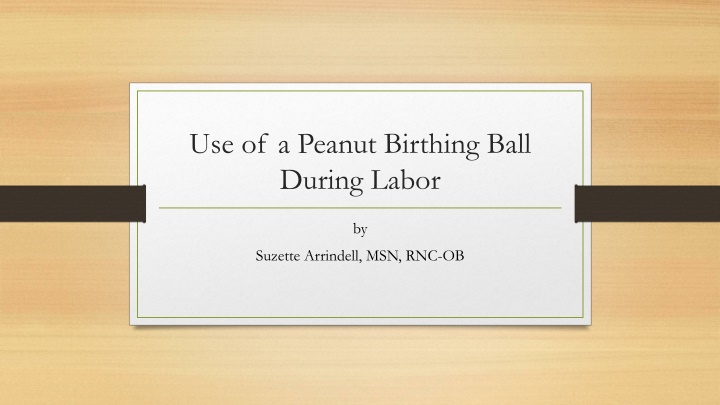Effectiveness of Peanut Birthing Ball in Laboring Mothers with Epidural
The use of a peanut birthing ball during labor for mothers with epidurals aims to reduce the duration of the first stage of labor and decrease the incidence of primary cesarean sections. Evidence suggests that peanut balls help open the maternal pelvis, aiding in fetal rotation and descent. This intervention can lead to shorter labor times and lower rates of cesarean deliveries, particularly beneficial for women with limited mobility due to epidural anesthesia. Implementing peanut balls presents opportunities for improving patient outcomes and satisfaction, although challenges such as patient resistance and staff training may arise.
Download Presentation

Please find below an Image/Link to download the presentation.
The content on the website is provided AS IS for your information and personal use only. It may not be sold, licensed, or shared on other websites without obtaining consent from the author.If you encounter any issues during the download, it is possible that the publisher has removed the file from their server.
You are allowed to download the files provided on this website for personal or commercial use, subject to the condition that they are used lawfully. All files are the property of their respective owners.
The content on the website is provided AS IS for your information and personal use only. It may not be sold, licensed, or shared on other websites without obtaining consent from the author.
E N D
Presentation Transcript
Use of a Peanut Birthing Ball During Labor by Suzette Arrindell, MSN, RNC-OB
PICO(T) QUESTION In laboring women, how does the use of a peanut ball, compared with not using a peanut ball, effect the length of first stage labor and the incidence of cesarean delivery?
PICO Patient population: Laboring mothers, specifically with an epidural for pain management Intervention: The use of a peanut birthing ball Comparator: Laboring mothers who do not utilize peanut birthing ball Outcome: Shorter duration of labor and decrease in primary cesarean sections
GAP analysis First stage of labor encompasses the onset of active labor to complete cervical dilation Longer duration of labor is associated with increase risk of cesarean section Repeat cesarean section deliveries account for highest number of cesarean births Epidural anesthesia results in limited mobility, which contributes to longer duration of labor
Evidence for intervention Peanut balls open the maternal pelvis, aiding in rotation and descent of the fetus (Roth, Dent, Parfit, Hering, & Bay, 2016). Women receiving epidural anesthesia are frequently in a modified-supine position, making the use of a peanut ball beneficial (Payton, 2015). Use of a peanut ball has been shown to decrease the length of both first and second stage labor and decrease the incidence of cesarean section delivery (Tussey, Botsios, Gerkin, Kelly, Gamez, & Mensik, 2015).
SWOT analysis (Reavy, 2016) Strengths Weaknesses Patient resistant to awkward position Repositioning every 20-60 minutes unappealing Environment that encourages change The exceptionally low cost of the equipment needed Non-invasive and non- pharmaceutical Opportunities Shorter laboring hours Lower cesarean section rates Opportunity to increase patient satisfaction Threats More experienced nurses resistant to change Physician buy-in
Projected budget Budget for materials Four peanut birthing balls at $40.00 each $160.00 Materials for posters and collection tool $100.00 Budget for staff time One hour needed for presentation and training for 35 nurses $1,400.00 (based on an average hourly salary of $40.00/hour Total projected cost $1,660.00
Project leader The presenter of this presentation is the most qualified to lead this project based on the following set of skills and experience: 14 years of experience as a Labor and Delivery nurse Over one year spent providing the research on the need for the projected project Experience with previous successful change projects lead by the presenter Willingness to facilitate the project from beginning to the culmination
Positions needed (Roles in change management, 2017) Project leader Develop plans for project Go-to person during the length of project Senior manager Authorize funding for project Unit manager Guides and support project team Project team Labor and delivery staff nurses to implement project Provide feedback on collection tool Project support team Experienced staff nurses Provide additional guidance and support throughout project process
References Payton, C. (2015). Use of a peanut ball to decrease first and second stages of labor. Graduate thesis, dissertations, and capstones, paper 14. Retrieved from http://scholarworks.bellarmine.edu/cgi/viewcontent.cgi?article=1013&context=tdc Reavy, K. (2016). Inquiry and leadership: A resource for the DNP project. Philadelphia, PA: F.A. Davis Company Roles in change management. (2017). Retrieved from https://www.prosci.com/change-management/thought- leadership-library/roles-in-change-management Roth, C., Dent, S., Parfit, S., Hering, S., & Bay, R. (2016). Use of the peanut ball during labor. American journal of maternal child nursing, 41(3), 140 146. doi: 10.1097/NMC.0000000000000232 Tussey, C., Botsios, E., Gerkin, R., Kelly, L., Gamez, J., & Mensik, J. (2015). Reducing length of labor and cesarean surgery rate using a peanut ball for women laboring with an epidural. Journal for perinatal education, 24(1), 16-24. doi: 10.1891/1058-1243.24.1.16























